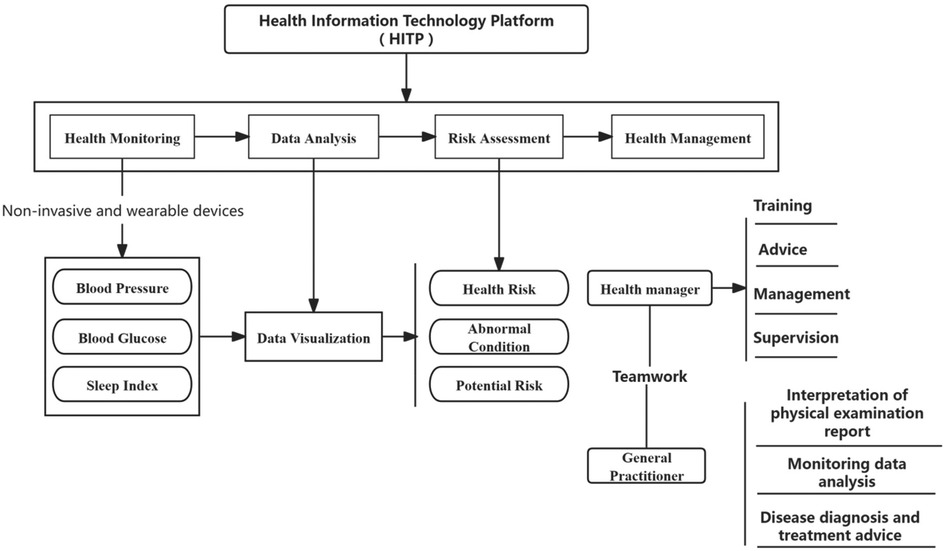- 1School of Public Health, The Key Laboratory of Environmental Pollution Monitoring and Disease Control, Ministry of Education, Guizhou Medical University, Guiyang, China
- 2Department of Teaching and Medical Management, Guiyang Sixth Hospital, Guiyang, China
- 3General Practice Hospital of Zunyi Medical University, Zunyi, China
- 4University Health Research Institute, Guizhou Medical University, Guiyang, China
- 5Department of Blood Transfusion, The Affiliated Hospital of Guizhou Medical University, Guiyang, China
Introduction: The health benefits of bamboo forest recreation on the human body are becoming increasingly recognized. However, limited research has focused on integrating environmental factor monitoring with smart platforms for population health management and assessment.
Method: This study monitors environmental parameters, including anion concentration, temperature, relative humidity, wind speed, acoustic environment, and volatile organic compounds in a bamboo forest, while recruiting elderly participants with essential hypertension, type II diabetes, and sleep disorders. A non-invasive wearable device was employed to track the health of the participants, followed by a 21-day precision health management intervention within the bamboo forest.
Results: The concentration of negative oxygen ions in this region exceeds 10,000 ions per cm3, alongside terpenes and other health-promoting volatile substances. A total of 70 participants participated in the platform. Compared to baseline measurements, hypertensive participants experienced significant reductions in systolic and diastolic blood pressure, as well as pulse rate (p < 0.001). Diabetic participants showed significant decreases in fasting and pre-bedtime blood glucose levels (p < 0.001), along with reduced blood glucose fluctuations post-meal. Participants with sleep disorders demonstrated statistically significant improvements in key sleep parameters, including the minimum blood oxygen level at sleep onset, the Oxygen Desaturation Index, wake frequency, percentage of rapid eye movement (REM) sleep, and subjective sleep quality (p < 0.05). The overall sleep quality score also showed significant improvement.
Conclusions: This study substantiates the therapeutic potential of bamboo forests in alleviating chronic diseases among the elderly, offering valuable insights for planning “bamboo bath” experiences.
1 Introduction
The accelerating global aging process has positioned chronic diseases in the elderly as a major public health challenge (1). Chronic conditions such as cardiovascular disease, chronic lung disease, cancer, obesity, diabetes, and kidney or liver disease are widespread. Among these, hypertension and diabetes place significant burdens on the elderly, while sleep disorders also complicate the management of conditions such as obesity, diabetes, and cardiovascular diseases (2–4). In response, non-pharmacological interventions, such as forest recreation, are emerging as potential solutions. Volatile organic compounds (VOCs) released by bamboo forests, such as terpenes, have strong antibacterial properties. Monoterpenes increase fluctuations in the brain and reduce b-waves, inducing a relatively sedated state (5, 6). Studies have shown that the microclimate (a cooling of 3°C–5°C and 80% humidity) can reduce the cardiovascular stress response (7). Bamboo flavonoids in bamboo leaves are used for the treatment of atherosclerosis, diabetes mellitus, and neurological diseases (8).
In recent years, the health benefits of forest recreation have garnered increasing interest from both forestry and medical researchers (9, 10). However, most of the forest medicine studies focus on youth populations (11), and only a few incorporate wearable devices (12), limiting the ability to quantify the dose–effect relationships of environmental exposure. This research, therefore, leverages a scientifically grounded health management platform to assess the effects of bamboo forest recreation. Environmental parameters—anion concentration, temperature, relative humidity, wind speed, acoustic environment, and VOC content—were monitored across four distinct locations at the Chishui Tianshuibao Forest Recreation Base, namely, along the lake trail (LT), the bamboo forest area (BF), the activity square (AS), and the residential area (RQ). Simultaneously, elderly individuals with chronic conditions participated in a 21-day bamboo forest recreation program. The study comprehensively evaluated the impact of this experience on blood pressure, blood glucose, and sleep disorders in the elderly population.
2 Materials and methods
2.1 Experimental design
This study was conducted at the Swan Castle Forest Recreation Base in Chishui City, where environmental parameters, including anion concentration, temperature, relative humidity, wind speed, acoustic environment, and VOC content, were monitored in real-time across four different locations in the bamboo forest. Three groups of elderly individuals, i.e., those with hypertension, type II diabetes mellitus, and sleep disorders, were recruited for the study. A health information platform was used to connect non-invasive wearable devices to continuously monitor the participants. The study followed a before-and-after self-control design, requiring participants to engage in at least 30 min of daily activity within the bamboo forest to ensure consistency. To maintain scientific rigor, dietary intake and nutrient ratios were standardized, with meal plans developed by a clinical nutritionist. In addition, weekly 1-h health lectures were held every Saturday morning for three consecutive weeks at the base by professors in the health management and general medicine fields, and general practitioners interpreted health check-up reports, analyzed data changes, and provided health promotion advice (Figure 1).
2.2 Experimental sites
The Swan Castle Forest Recreation Base (Figure 2), located in the northwestern part of Guizhou Province in Zunyi City at an elevation of 1,200–1,450 m, was selected as the study site (Figure 3). The base spans 20 km2 of virgin forests, with 96% of the surrounding area covered by trees. There are 21 species of bamboo, with Nanzhu (a variety of moso bamboo) comprising approximately 70% of the total bamboo area. The site benefits from a favorable climate and ecological environment, with an annual average temperature of 18.1°C and an average of 21°C from June to October. This combination of factors creates a fresh, natural, and pleasant atmosphere. The recreation base features forest trails, lakeside trails, and areas designated for activities such as Tai Chi, Baduanjin, and yoga.
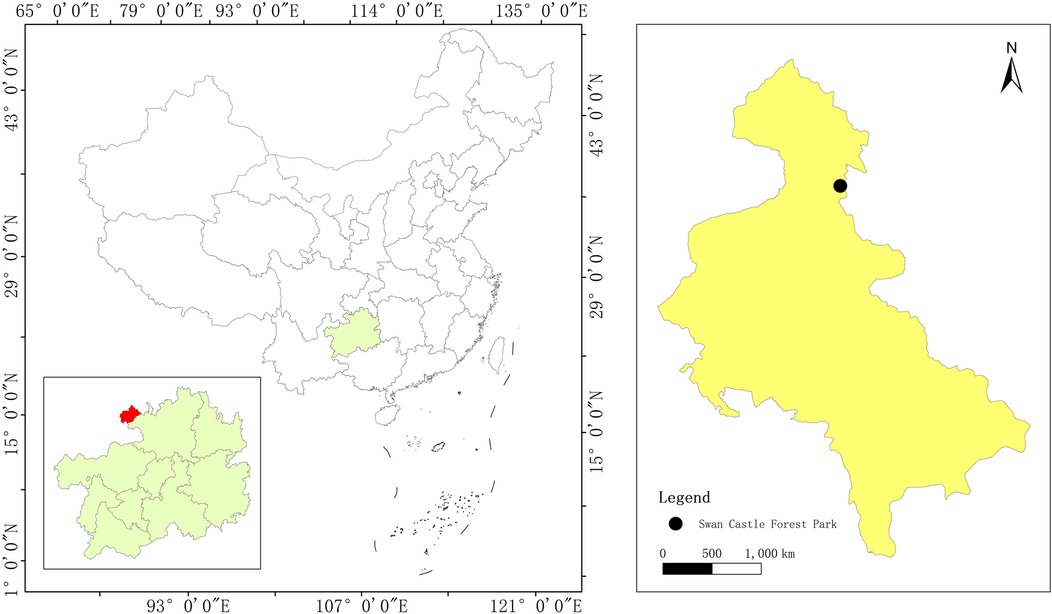
Figure 2. Map of the experimental site. The red area marks the Chishui City area, and the black dot marks the location of the experimental site.
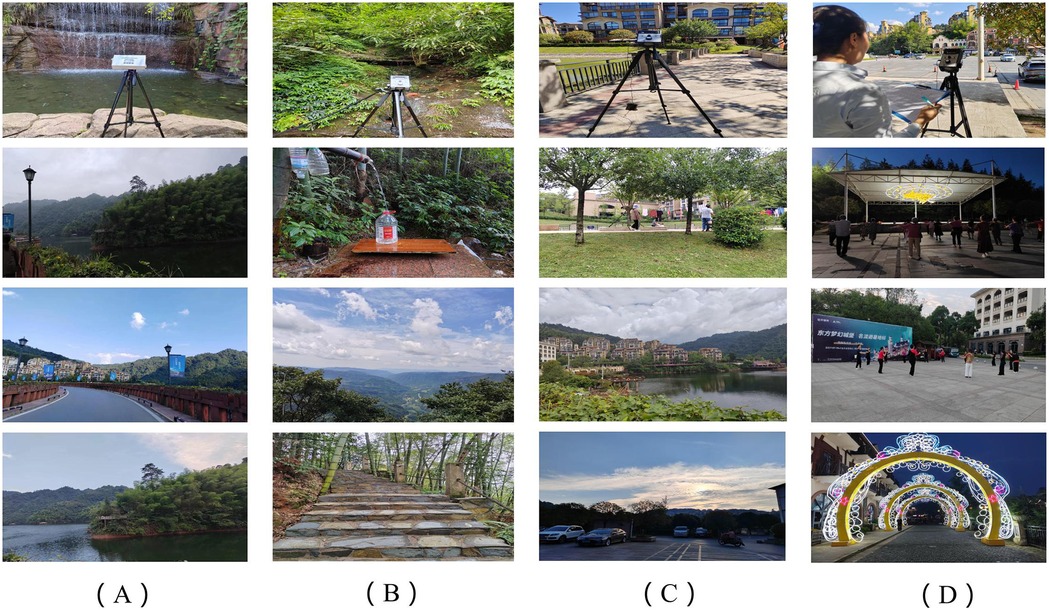
Figure 3. Images of the monitoring sites. (A) The trail along the lake, (B) the bamboo forest area, (C) the residential area, and (D) the activity square.
2.3 Participants
Participants for this study were recruited between August and September 2023, both on-site and via the Internet. Recruitment was organized into three groups, namely, the hypertension, diabetes, and sleep disorder groups. The hypertension group comprised 25 participants, with a mean age of 70.60 ± 5.08 years, all meeting the diagnostic criteria for essential hypertension (as defined by the 2017 American Heart Association guidelines, with systolic blood pressure (SBP) > 140 mmHg and diastolic blood pressure (DBP) > 90 mmHg) (13). The diabetes group included 22 participants (none were insulin-dependent, as per the American Diabetes Society 2017 guidelines) (14), with a mean age of 69.71 ± 7.42 years. The sleep disorder group consisted of 23 volunteers, with a mean age of 67.00 ± 4.44 years, all self-reporting sleep disturbances such as insomnia, difficulty falling asleep, poor sleep quality, early waking, excessive sleepiness, or sleep-related breathing disorders (Table 1). Volunteers were required to meet the following inclusion criteria: (1) no psychiatric disorders and the ability to independently perform daily activities, (2) commitment to a 21-day bamboo forest recreation program, and (3) no participation in forest recreation or similar trips within the past 6 months. Exclusion criteria included severe heart, liver, spleen, lung, and kidney diseases; immunological disorders; infectious diseases; and dependence on drugs, alcohol, cocaine, or other substances. The recruitment process adhered to the Declaration of Helsinki 1964 and its subsequent amendments, or comparable ethical standards, and was approved by the Ethics Committee of Guizhou Medical University. Prior to the study, the purpose and procedures of the experiment were thoroughly explained to all volunteers, who provided written informed consent.
2.4 Measurements
2.4.1 Monitoring of environmental parameters
After collecting environmental parameters from four activity sites with significant landscape differences, the daily route for the bamboo forest recreation program was developed based on the feedback from forestry and medical experts. Four key locations were selected for monitoring (Figure 4), namely, the LT, the BF, the AS, and the RQ. An AIC-1000 negative ion detector was used to measure the negative ion concentration in the air, while a Kestrel-3500 digital thermometer-hygrometer recorded air temperature, relative humidity, and wind speed. In addition, an SM-350 decibel tester monitored noise levels. All environmental parameters were measured at 2-hour intervals between 9:00 a.m. and 5:00 p.m. each day. For each monitoring point, three consecutive sets of readings were taken after the instrument values stabilized. Temperature, relative humidity, and wind speed were then used in Equation (1) to calculate the human comfort level. The human comfort index (HCI) evaluates the reaction of the human body to the external environment, and is calculated using the following formula:
where HCI represents the composite comfort index, T denotes the temperature (°C), H represents the relative humidity (%), and V denotes the wind speed (m/s).
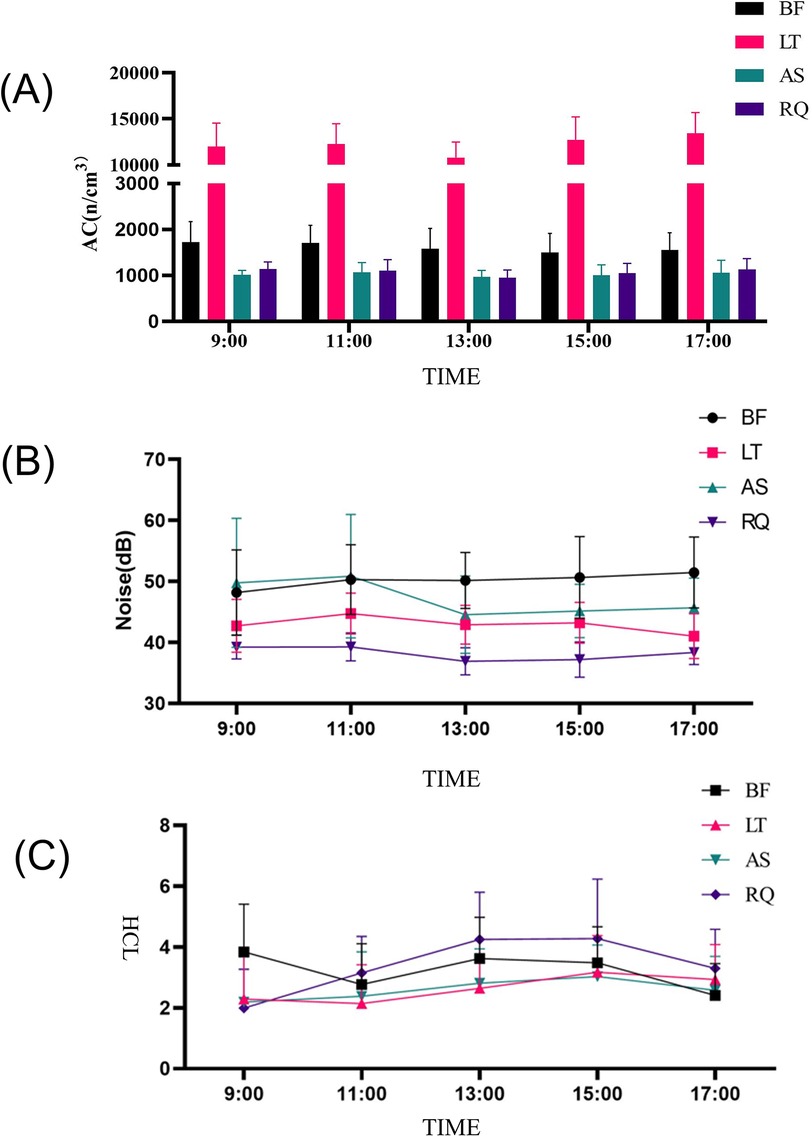
Figure 4. Environmental parameters at the study site were monitored. (A) The change of negative oxygen ion concentration. (B) The change of sound level. (C) The change in the human comfort index. Data are presented as mean ± SE. LT, trail along the lake; BF, bamboo forest area; AS, activity square; RQ, residential area.
2.4.2 Collection and detection of volatile substances from bamboo forests
A standard sample plot of the bamboo forest, measuring 20 m × 20 m, was established more than 20 m from the main road on a slope of no more than 23°. Data collection was conducted every 2 h on 13 September (a sunny day with no wind) from 10:00 to 16:00, with a collection time of 1.5 h. VOCs released by bamboo forests were collected using a JK-CYQ001 portable flow-adjustable atmospheric sampler (Jukai Kechuang, China) with open-ended collection. Simultaneously, fresh leaves from three healthy, disease-free bamboos were collected from the sample plot at 5-m intervals and labeled. The bamboo leaves were cut into pieces, and approximately 2.7 g of the mixed sample was weighed and placed in the sampling vial of the solid-phase microextractor (SPME). The air was removed directly into the extraction needle for extraction. The vial was then inserted into a manual injector equipped with a 2 cm-50/30 μm DVB/CAR/PDMS StableFlex fiber tip. Extraction was performed under headspace conditions at 80°C for 60 min, with air extraction at room temperature. After extraction, the fiber tip was removed and immediately inserted into the gas chromatograph, where the sample was thermally resolved in the spectrometer inlet at 250°C. The VOC components of the bamboo forest were analyzed using an HP6890/5975C GC/MS coupled instrument (Agilent Technologies, Inc., CA, USA) with headspace solid-phase microextraction-gas chromatography-mass spectrometry (HS-SPME-GC-MS). Peaks in the total ion chromatogram were identified using a mass spectrometry data system and cross-referenced with the NIST20 and Wiley275 standard databases. The relative mass fractions of the chemical components were calculated using the peak area normalization method. A flexible quartz capillary column, HP-5MS (60 m × 0.25 mm × 0.25 μm), was employed with an initial temperature of 45°C (held for 2 min). The temperature was then raised to 185°C at 3.5°C/min and further to 310°C at 10°C/min, with a total running time of 54.5 min. The vaporization chamber temperature was set to 250°C, and high-purity helium (99.999%) was used as the carrier gas at a flow rate of 1.0 ml/min, with a pre-column pressure of 16.28 psi. The ion source was an electron ionization (EI) source with a temperature of 230°C, a quadrupole temperature of 150°C, an electron energy of 70 eV, an emission current of 34.6 μA, a multiplier voltage of 1671 V, and an interface temperature of 280°C. The mass range was set from 29 to 500 amu.
2.4.3 Measurement of health indicators
2.4.3.1 Functions of the health information platform
The health informatization platform integrated various monitoring systems, including a Huawei hypertension monitoring watch [HUAWEIWATCHD (MLY-B10)] for SBP and DBP measurement, a Sannuo continuous glucose monitoring system (China) for blood glucose tracking, and a Sannuo sleep monitoring service system (China) for assessing sleep conditions (including sleep quality, sleep onset latency, duration, efficiency, sleep disorders, use of hypnotic drugs, and daytime dysfunction). In addition, blood oxygen levels, sleep structure, and heart rate (HR) statistics were recorded (Table 2). Data on blood pressure and blood glucose were captured every 5 min and automatically uploaded to the platform, while the sleep device tracked changes in oxygen saturation, HR, and related parameters using infrared light.
2.4.3.2 Pittsburgh Sleep Quality Index
The Pittsburgh Sleep Quality Index (PSQI) encompasses seven components, namely, subjective sleep quality, sleep onset latency, sleep duration, sleep efficiency, sleep disorders, use of hypnotic drugs, and daytime dysfunction. Each component is scored on a scale from 0 to 3, with the total PSQI score ranging from 0 to 21. Higher scores indicate poorer sleep quality, and a PSQI score of ≥8 suggests a sleep disorder. The Cronbach's alpha for the scale was 0.82, and the McDonald's omega index was 0.73.
2.5 Data analysis
Data were analyzed using Jamovi 2.3.28 and Excel 2019. Quantitative data are presented as mean ± SD, while qualitative data are expressed as frequency and percentage. The Shapiro–Wilk test (S–W test) and Levene's test were conducted to assess normality and variance, respectively. For normally distributed samples with equal variances, paired t-tests were employed for group comparisons. Non-parametric tests (Mann–Whitney U test or Wilcoxon signed ranks test) were applied for non-normally distributed or unequal variance data. A p-value of <0.05 was considered statistically significant. Graphs were generated using GraphPad Prism 8.3.0.
3 Results
3.1 Analysis of daily trends in environmental factors
The daily fluctuations in negative oxygen ion concentration at the four monitoring points—the bamboo forest trail, the lakeside trail, the activity plaza, and the residential area—remained relatively stable, following a consistent pattern of “high in the morning, low at noon, and high in the afternoon.” The only deviation occurred at 13:00, when both the square and residential hut exhibited a notable dip in concentrations. The sound decibel measurement across all monitoring points during each time period remained within the comfortable range, and the HCI was consistently below 4.55, classifying the environment as level “I” (Figure 4).
3.2 Daily dynamics of volatile organic compounds in bamboo forests
Details regarding the collection methods, fractions, and relative concentrations of VOCs in the moso bamboo forest at various time periods are provided in Supplementary Table S1 and Figure 5. A total of 101 compounds were detected using two analytical methods, with 55 volatile compounds identified in fresh leaves, including 35 alkanes, 19 terpenoids, 2 aromatic hydrocarbons, 16 aldehydes, 5 ketones, 1 acid, 13 alcohols, 8 esters, and 2 others. The volatile compounds peaked daily at 14:00, with terpenes, alcohols, and esters exhibiting minimal variation over time (10:00–16:00). Ketones and acids were present only in small quantities at 14:00 and were absent at other times.
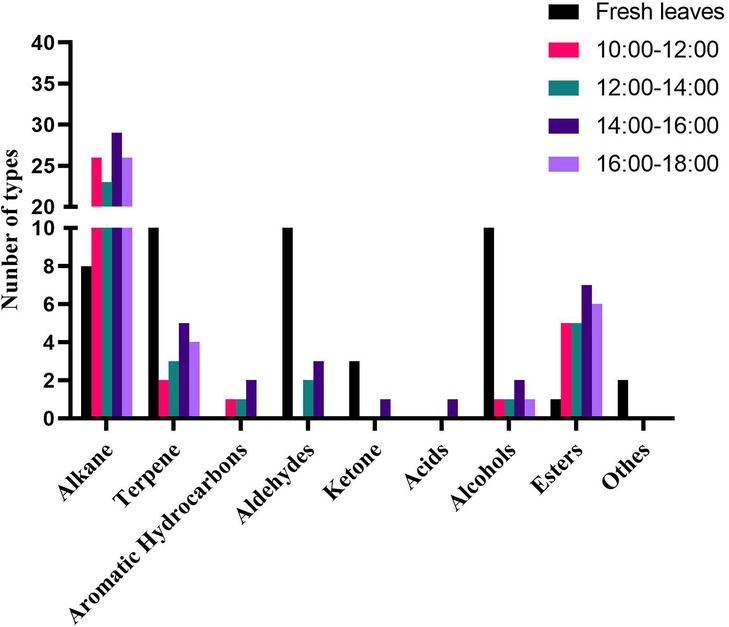
Figure 5. Components of volatile organic compounds using different methods and at different time periods. Data are presented as mean ± SE.
3.3 Bamboo forest wellness for elderly individuals with hypertension
Following 3 weeks of intervention, diastolic blood pressure, systolic blood pressure, and pulse exhibited considerable fluctuations during the first week, became more stable in the second week, and remained consistently below 140/90 mmHg in the third week. Systolic blood pressure showed significant variation across all three weeks, while diastolic blood pressure and pulse were markedly lower after the third week compared to the first week (Figure 6, p < 0.001).
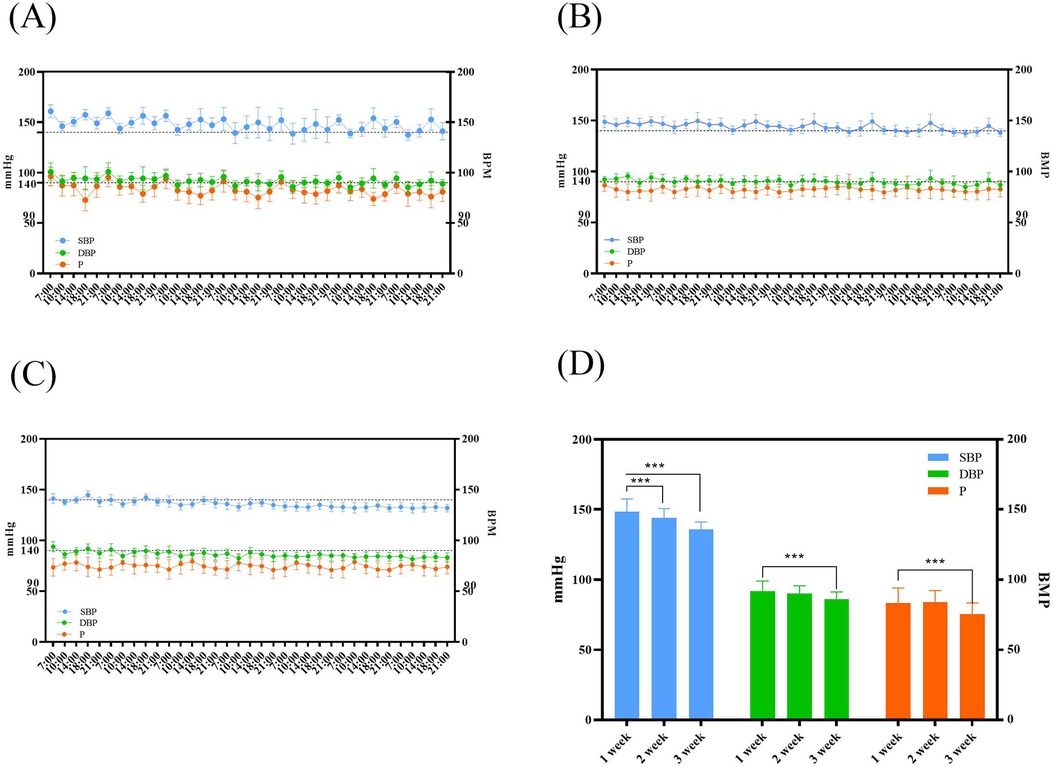
Figure 6. Effect of bamboo forest bathing on blood pressure in dicators insubjects (n = 25). (A) the first week of intervention; (B) the second week of intervention; (C) the third week of intervention; (D) Differential analysis of the three-week intervention effects. The systolic blood pressure (SBP), diastolic blood pressure (DBP) and pulse pressure (PP) of subject was measured via a Huawei Blood pressure monitoring watch before and after the experiment. ***p < 0.001, analyzed by Mann–Whitney U test.
3.4 Effect of bamboo forest recreation on changes in blood glucose values
During the intervention period, fasting blood glucose, 2-h postprandial blood glucose, and bedtime blood glucose fluctuated in the first week, then steadily declined and stabilized in the second and third weeks. When compared to the first week, fasting blood glucose (p < 0.05) and bedtime blood glucose (p < 0.001) were significantly reduced in the second week, with all blood glucose levels—fasting, postprandial, and bedtime—being significantly lower in the third week (Figure 7, p < 0.001).
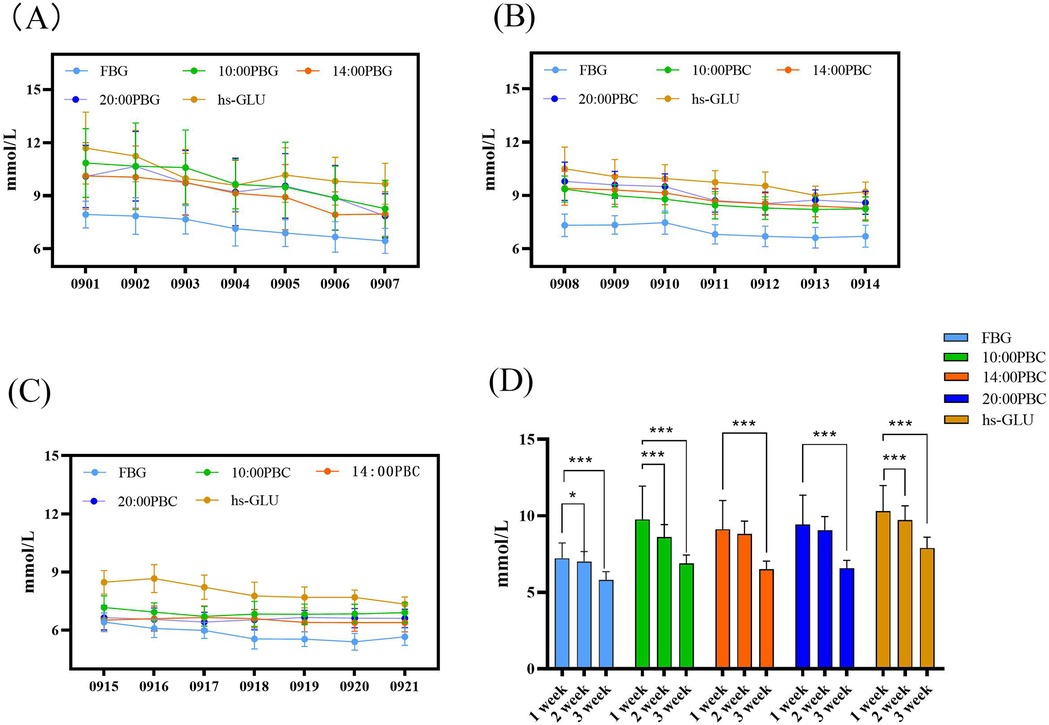
Figure 7. Blood glucose values of participants before and after bamboo forest healthcare activities in (A) the first week of the intervention, (B) the second week of the intervention, and (C) the third week of the intervention. (D) Differential analysis of the 3-week intervention effects. *p < 0.05, ***p < 0.001, as calculated by the Mann–Whitney U test.
3.5 Changes in sleep quality indicators after bamboo forest recreation activities
Post-intervention, sleep quality, sleep onset latency, sleep duration, sleep efficiency, hypnotic medication use, and daytime dysfunction, as assessed by the PSQI, all showed significant improvement (Figure 8, p < 0.05). The oxygen desaturation index (ODI) significantly decreased (Table 3), while objective composite scores, the number of awakenings, minimum blood oxygen levels during sleep onset, and REM sleep increased significantly (p < 0.001). No significant differences were observed between pre- and post-intervention for mean blood oxygen levels and total sleep duration (Table 3).
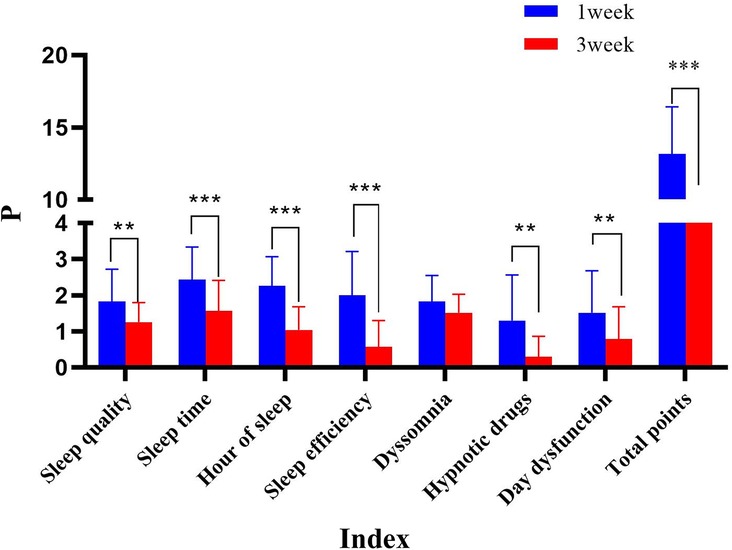
Figure 8. Pittsburgh Sleep Quality Index (PSQI) changes in sleep quality, sleep duration, sleep duration, sleep efficiency, sleep disorders, hypno drugs, and daytime dysfunction before and after the intervention. **p < 0.01. ***p < 0.001, as calculated by the Mann–Whitney U test.

Table 3. Data from sleep monitoring equipment comparing the changes in sleep indicators before and after the healthcare intervention.
4 Discussion
The results of the study indicate that after 3 weeks of centralized health management intervention in the bamboo forest environment, the elderly population experienced significant improvements in sleep quality, blood pressure, and blood glucose levels, with statistically significant differences compared to the pre-trial period (p < 0.05). These positive health changes primarily reflect the effectiveness and efficiency of the centralized health management model based on the bamboo forest ecosystem.
The impact of forest recreation on population health has become a prominent area of research in recent years. Forest retreats are a vital component of non-pharmacological therapies. Some forward-looking scholars suggest that novel techniques, such as virtual environment therapy, can improve the physical and mental health of older adults and caregivers (15, 16). McEwan et al. experimentally confirmed that both real and VOC-rich environments positively impact adults with mobility impairments and/or low energy levels (17). At the same time, scholars have studied the effects of a four-season camphor forest environment and confirmed the therapeutic benefits of balsam fir forests for hypertension in the elderly (18). Similarly, Lyu (19) demonstrated the physiological and psychological advantages of a 3-day bamboo forest therapy program for college students. Our research team explored the waterfall forest environment and found that it positively influenced emotional perception, preferences, and stress recovery, while also improving psychological, physiological, and metabolite levels in individuals suffering from chronic fatigue syndrome (20, 21).
Environmental changes and the release of plant essences play a critical role in forest recreation, with health benefits mediated through the five human senses—sight, smell, hearing, touch, and taste (22). Negative air ions, often referred to as “air vitamins and growth factors,” have been shown to have remarkable health benefits for the human body (23). From a medical standpoint, long-term exposure to an environment with a negative air ion concentration between 1,000 and 5,000 ions/cm3 strengthens the immune system and enhances its resistance. In environments where the concentration reaches 5,000–10,000 ions/cm3, the benefits of negative ions are further amplified.
Negative ions have been shown to kill airborne bacteria, thereby reducing disease transmission. When the human body is exposed to airborne negative ions at concentrations exceeding 10,000 ions/cm3, it stimulates the body's natural healing mechanisms against diseases. Studies have demonstrated that exposure to high concentrations of negative ions can enhance mood and improve cardiac autonomic function (24, 25). In this study, environmental parameters were measured at four recreation sites within the recreation base, revealing high concentrations of negative ions at most locations, except for the plaza and the residential hut, where the midday concentration fell below 1,000 ions/cm3. The HCI, derived from ambient temperature, relative humidity, and wind speed, serves as a useful tool for guiding the spatial planning of scenic spots and the scheduling of tourist activities. The HCI of all four monitoring points was classified as “I” level across all time periods. Acoustic environment monitoring data indicated that noise levels at each time point were below 70 dB, suggesting that the Chishui Swan Castle Forest Recreation Base is conducive to recreational activities, in terms of anion concentration, acoustic conditions, and human comfort.
VOCs are secondary metabolites that plants synthesize, typically with a relative molecular mass of 100–200 (26). In this study, two methods—air collection and fresh branch and leaf extraction—were used to gather VOCs from the moso bamboo forest, detecting a total of 100 compounds. Alkanes and esters predominated in the air at various times, while 55 volatile compounds were identified in fresh leaves, with terpenoids being the most abundant. These findings are consistent with those of previous studies (22, 27). Previous studies have highlighted the antioxidant and immunomodulatory properties of compounds such as d-limonene (28) and α-pinene (29), while neophytadiene (30), stigmasterol (BCP) (31), and lobotene (BO) (32) have demonstrated significant effects on alleviating anxiety and cardiovascular diseases. In addition, this study detected other potentially beneficial substances, including α-cubebene (-)-, α-farnesene, 2-octene (E)-, and small amounts of aromatic hydrocarbons and esters such as ethyl acetate (Supplementary Table S1).
This study employed a health informatics platform to evaluate the physiological benefits of a health management intervention for hypertensive patients in a bamboo forest environment. The platform facilitates continuous and accurate health management by integrating various wearable devices, ensuring unified data management and real-time monitoring. The data mining platform comprises four key components, namely, health monitoring, data analysis, risk assessment, and health management. The system is designed to manage roles and permissions, conduct risk assessments, provide alerts and automatic reminders, enable multidimensional evaluation, and offer health guidance and follow-up management. Wearable smart devices allow for continuous health monitoring, with the collected data uploaded and stored on a cloud platform, facilitating the development of personalized health management programs. After 3 weeks of intervention, the participants exhibited a stabilizing trend in systolic blood pressure, diastolic blood pressure, and pulse rate, with significant reductions over time. Our findings align with previous studies, which demonstrated the efficacy of combining bamboo forest recreation with health informatics in managing hypertension in the elderly (18, 33, 34). Huang conducted an experiment in a balsam fir forest through forest bathing across four seasons, showing that blood pressure (both DBP and SBP), HR, endothelin-1 (ET-1), and SpO2 levels improved in elderly participants (18). In addition, forest bathing was found to reduce serum cortisol, urinary epinephrine, and sympathetic nerve activity, which regulate systolic and diastolic blood pressure in elderly hypertensive patients (35). Previous studies have also confirmed similar results (19). Furthermore, research has shown that high concentrations of negative oxygen ions, inhaled through the respiratory system, enter the bloodstream and reach tissues and organs via membrane exchange, thereby exerting physiological regulatory effects by stimulating nerve reflexes and the humoral system (36).
Type 2 diabetes mellitus is an endocrine metabolic disorder characterized by hyperglycemia, which results from various etiological factors (37). The present study assessed changes in five key indicators of blood glucose levels—fasting blood glucose, 2-h postprandial blood glucose, and bedtime blood glucose—over a 3-week period. After 1 week of wellness, a decreasing trend in blood glucose was observed at 14:00 and 20:00, though the changes were not statistically significant compared to baseline levels. The glucose levels continued to decrease gradually, with a significant reduction after 3 weeks of wellness, showing a marked difference (within the normal range) compared to 1 week of wellness. Similarly, after 1 week of recuperation, blood glucose at 14:00 and 20:00 exhibited a decreasing trend, but the difference was not significant when compared to the pre-recovery levels. After 3 weeks of recuperation, the levels significantly decreased, with a notable difference compared to the first week of recuperation (within the normal range). These findings are consistent with previous research (38). Plant volatiles notably reduce urinary epinephrine and norepinephrine levels, inhibit sympathetic nerve activity, enhance parasympathetic nerve activity, and lower serum levels of IL-6, IL-18, and TNF-α (22). In addition, walking in bamboo forests has been shown to increase metabolism, glucose consumption, and energy expenditure. This results in improved muscle tissue insulin sensitivity, decreased serum stress hormone levels, and alleviation of the stress response. Therefore, the bamboo forest environment, in combination with a wellness-focused approach, promotes health and wellbeing. Furthermore, the integration of an information technology platform can contribute to blood glucose regulation to a certain extent.
Sleep disorders among older adults are prevalent yet often underdiagnosed, encompassing conditions such as insomnia, difficulty falling asleep, poor sleep quality, early awakening, excessive sleepiness, and sleep-related breathing disturbances (39). In this study, the improvement in sleep was assessed using both subjective measurements through the PSQI sleep quality scale and objective monitoring via portable equipment. Statistically significant improvements were observed in total PSQI scores, sleep quality, sleep onset latency, sleep duration, sleep efficiency, use of hypnotic medications, and daytime dysfunction following the recuperation period. According to the blood oxygen levels and sleep structure data collected from portable equipment, maintaining a blood oxygen concentration above 90 is crucial for sustaining good sleep quality, with the minimum blood oxygen level during sleep onset being statistically significant. The ODI, used to evaluate the effects of the bamboo forest recuperation on sleep improvement, demonstrated a significant reduction after the intervention, indicating a positive outcome. The number of awakenings in healthy individuals typically ranges from 0 to 5, and while the number of awakenings before and after the intervention in this study remained within the normal range, a statistically significant difference was observed. In addition, the REM sleep duration and objective composite scores were significantly higher post-intervention compared to pre-recovery levels. These findings suggest that the intervention was effective in improving the participants' sleep quality. Previous studies have indicated that forest walking improves nocturnal sleep in individuals with sleep disturbances (40). This improvement may be attributed to a combination of physical exercise, mood enhancement, targeted health education (41), and dietary and exercise management (41, 42).
All participants were under daily management by the Bamboo Forest Retreat research team. This study aimed to explore the adjunctive therapeutic effects of a 21-day (3-week) bamboo forest retreat combined with a health informatics platform and various health management interventions on chronic diseases in the elderly. As a pilot study, it may not fully align with existing research evidence in some aspects. Future studies will refine the experimental design based on these findings and aim for broader application.
Data availability statement
The datasets presented in this article are not readily available. Requests to access the datasets should be directed to Jing He,MjM1MDg0OTQyOEBxcS5jb20=.
Ethics statement
The studies involving humans were approved by the Ethics Committee of GuiZhou Medical University. The studies were conducted in accordance with the local legislation and institutional requirements. The participants provided their written informed consent to participate in this study.
Author contributions
JH: Investigation, Software, Writing – original draft. RW: Investigation, Writing – original draft. XX: Conceptualization, Investigation, Writing – review & editing. JZ: Conceptualization, Project administration, Writing – original draft. YL: Investigation, Project administration, Writing – original draft. ZZ: Methodology, Supervision, writing – review & editing. YC: Funding acquisition, Project administration, Writing – review & editing.
Funding
The author(s) declare that financial support was received for the research and/or publication of this article. This study was supported by the Characteristic Forestry Industry Research Project of Guizhou Province (Approval No.: GZMC-ZD 20202091), the Science and Technology Plan Project of Guizhou Province (Approval No.: General 392), the Guizhou Province Theoretical Innovation Project (Commissioned Project) (Project no. GZLCWT-2023-5), and the Guizhou Provincial Basic Research Program (Natural Science) (Approval No. QKHJC-zk2025449).
Acknowledgments
We would like to thank the Guizhou Forestry Bureau, Department of Science and Technology of Guizhou Province, for their funding support and the Chishui Municipal People's Government and relevant units for their valuable help in data collection. We thank Bullet Edits Limited for the linguistic editing and proofreading of the manuscript.
Conflict of interest
The authors declare that the research was conducted in the absence of any commercial or financial relationships that could be construed as a potential conflict of interest.
Publisher's note
All claims expressed in this article are solely those of the authors and do not necessarily represent those of their affiliated organizations, or those of the publisher, the editors and the reviewers. Any product that may be evaluated in this article, or claim that may be made by its manufacturer, is not guaranteed or endorsed by the publisher.
Supplementary material
The Supplementary Material for this article can be found online at: https://www.frontiersin.org/articles/10.3389/fenvh.2025.1432082/full#supplementary-material
References
1. Wang Y, Jiang G, Wang L, Chen M, Yang K, Wen K, et al. Association of the depressive scores, depressive symptoms, and conversion patterns of depressive symptoms with the risk of new-onset chronic diseases and multimorbidity in the middle-aged and elderly Chinese population. eClinicalMedicine. (2022) 52:101603. doi: 10.1016/j.eclinm.2022.101603
2. Assessment of Changes in Lipids Metabolism in Patients with Degenerative Joints and Discs Diseases Subjected to Spa Therapy - PubMed. Available at: https://pubmed.ncbi.nlm.nih.gov/31428637/ (Accessed March 21, 2025).
3. Sleep and Cardiovascular Risk - PubMed. Available at: https://pubmed.ncbi.nlm.nih.gov/34325825/ (Accessed March 21, 2025).
4. Schipper SBJ, Van Veen MM, Elders PJM, van Straten A, Van Der Werf YD, Knutson KL, et al. Sleep disorders in people with type 2 diabetes and associated health outcomes: a review of the literature. Diabetologia. (2021) 64(11):2367–77. doi: 10.1007/s00125-021-05541-0
5. Kasuya H, Iida S, Ono K, Satou T, Koike K. Intracerebral distribution of a-pinene and the anxiolytic-like effect in mice following inhaled administration of essential oil from Chamaecyparis obtuse. Nat Prod Commun. (2015) 10(8):1479–82.26434146
6. Linck VM, da Silva AL, Figueiró M, Caramão EB, Moreno PRH, Elisabetsky E. Effects of inhaled linalool in anxiety, social interaction and aggressive behavior in mice. Phytomedicine. (2010) 17(8–9):679–83. doi: 10.1016/j.phymed.2009.10.002
7. Du Z, Xiong F, Tang Y, Xia X, Hu Y, Wang F. The impact of meteorological conditions on cardiovascular and cerebrovascular diseases in different microclimatic zones of low-latitude mountainous areas. Front Public Health. (2024) 12:1447910. doi: 10.3389/fpubh.2024.1447910
8. Cheng Y, Wan S, Yao L, Lin D, Wu T, Chen Y, et al. Bamboo leaf: a review of traditional medicinal property, phytochemistry, pharmacology, and purification technology. J Ethnopharmacol. (2023) 306:116166. doi: 10.1016/j.jep.2023.116166
9. Antonelli M, Donelli D, Barbieri G, Valussi M, Maggini V, Firenzuoli F. Forest volatile organic compounds and their effects on human health: a state-of-the-art review. Int J Environ Res Public Health. (2020) 17(18):6506. doi: 10.3390/ijerph17186506
10. Zeng C, Lyu B, Deng S, Yu Y, Li N, Lin W, et al. Benefits of a three-day bamboo forest therapy session on the physiological responses of university students. Int J Environ Res Public Health. (2020) 17(9):3238. doi: 10.3390/ijerph17093238
11. Miyazaki Y, Ikei H, Song C. Forest medicine research in Japan. Nihon Eiseigaku Zasshi. (2014) 69(2):122–35. doi: 10.1265/jjh.69.122
12. Gomez Palacios LR, Bracamonte AG. Development of nano- and microdevices for the next generation of biotechnology, wearables and miniaturized instrumentation. RSC Adv. (2022) 12(20):12806–22. doi: 10.1039/D2RA02008D
13. Patterns of hypertension management in France in 2015: The ESTEBAN survey - PubMed. Available at: https://pubmed.ncbi.nlm.nih.gov/32092238/ (Accessed March 21, 2025).
14. Harreiter J, Roden M. Diabetes mellitus-definition, classification, diagnosis, screening and prevention (update 2019). Wien Klin Wochenschr. (2019) 131(1):6–15. doi: 10.1007/s00508-019-1450-4
15. Clemente D, Romano L, Zamboni E, Carrus G, Panno A. Forest therapy using virtual reality in the older population: a systematic review. Front Psychol. (2024) 14:1323758. doi: 10.3389/fpsyg.2023.1323758
16. Clemente D, Romano L, Russo C, Carrus G, Panno A. 3D built virtual Arctic environment increase vigor through connectedness in older people. Sci Rep. (2024) 14(1):23432. doi: 10.1038/s41598-024-74593-0
17. McEwan K, Krogh KS, Dunlop K, Khan M, Krogh A. Virtual forest bathing programming as experienced by disabled adults with mobility impairments and/or low energy: a qualitative study. Forests. (2023) 14(5):1033. doi: 10.3390/f14051033
18. Huang R, Li A, Li Z, Chen Z, Zhou B, Wang G. Adjunctive therapeutic effects of forest bathing trips on geriatric hypertension: results from an on-site experiment in the Cinnamomum camphora forest environment in four seasons. Forests. (2023) 14(1):75. doi: 10.3390/f14010075
19. Lyu B, Zeng C, Xie S, Li D, Lin W, Li N, et al. Benefits of a three-day bamboo forest therapy session on the psychophysiology and immune system responses of male college students. Int J Environ Res Public Health. (2019) 16(24):4991. doi: 10.3390/ijerph16244991
20. Zhu Z, Zhao X, Zhu L, Xiong Y, Cong S, Zhou M, et al. Effects of short-term waterfall forest aerosol air exposure on rat lung proteomics. Ann Transl Med. (2022) 10(22):1223. doi: 10.21037/atm-22-4813
21. Zhu Z, Zhao X, Ouyang Q, Cong S, Zhou M, Xiong Y, et al. Mechanism of the Huangguoshu waterfall forest environment’s promotive effect on human health in Guizhou, China. Ann Transl Med. (2022) 10(16):894. doi: 10.21037/atm-22-3787
22. Antonelli M, Barbieri G, Donelli D. Effects of forest bathing (shinrin-yoku) on levels of cortisol as a stress biomarker: a systematic review and meta-analysis. Int J Biometeorol. (2019) 63(8):1117–34. doi: 10.1007/s00484-019-01717-x
23. Li A, Li Q, Zhou B, Ge X, Cao Y. Temporal dynamics of negative air ion concentration and its relationship with environmental factors: results from long-term on-site monitoring. Sci Total Environ. (2022) 832:155057. doi: 10.1016/j.scitotenv.2022.155057
24. Liu S, Li C, Chu M, Zhang W, Wang W, Wang Y, et al. Associations of forest negative air ions exposure with cardiac autonomic nervous function and the related metabolic linkages: a repeated-measure panel study. Sci Total Environ. (2022) 850:158019. doi: 10.1016/j.scitotenv.2022.158019
25. Hu Y-Q, Niu T-T, Xu J-M, Peng L, Sun Q-H, Huang Y, et al. Negative air ion exposure ameliorates depression-like behaviors induced by chronic mild stress in mice. Environ Sci Pollut Res Int. (2022) 29(41):62626–36. doi: 10.1007/s11356-022-20144-x
26. Meneguzzo F, Albanese L, Bartolini G, Zabini F. Temporal and spatial variability of volatile organic compounds in the forest atmosphere. Int J Environ Res Public Health. (2019) 16(24):4915. doi: 10.3390/ijerph16244915
27. Chung MJ, Cheng SS, Lin CY, Chang ST. Profiling of volatile compounds of Phyllostachys pubescens shoots in Taiwan. Food Chem. (2012) 134(4):1732–7. doi: 10.1016/j.foodchem.2012.03.120
28. Anandakumar P, Kamaraj S, Vanitha MK. D-limonene: a multifunctional compound with potent therapeutic effects. J Food Biochem. (2021) 45(1):e13566. doi: 10.1111/jfbc.13566
29. Salehi B, Upadhyay S, Erdogan Orhan I, Kumar Jugran A, Jayaweera SLD, Dias DA, et al. Therapeutic potential of α- and β-pinene: a miracle gift of nature. Biomolecules. (2019) 9(11):738. doi: 10.3390/biom9110738
30. Gonzalez-Rivera ML, Barragan-Galvez JC, Gasca-Martínez D, Hidalgo-Figueroa S, Isiordia-Espinoza M, Alonso-Castro AJ. In vivo neuropharmacological effects of neophytadiene. Molecules. (2023) 28(8):3457. doi: 10.3390/molecules28083457
31. Scandiffio R, Geddo F, Cottone E, Querio G, Antoniotti S, Gallo MP, et al. Protective effects of (E)-β-caryophyllene (BCP) in chronic inflammation. Nutrients. (2020) 12(11):3273. doi: 10.3390/nu12113273
32. Liu S, Long Y, Yu S, Zhang D, Yang Q, Ci Z, et al. Borneol in cardio-cerebrovascular diseases: pharmacological actions, mechanisms, and therapeutics. Pharmacol Res. (2021) 169:105627. doi: 10.1016/j.phrs.2021.105627
33. Ideno Y, Hayashi K, Abe Y, Ueda K, Iso H, Noda M, et al. Blood pressure-lowering effect of Shinrin-yoku (forest bathing): a systematic review and meta-analysis. BMC Complement Altern Med. (2017) 17(1):409. doi: 10.1186/s12906-017-1912-z
34. Yau KK-Y, Loke AY. Effects of forest bathing on pre-hypertensive and hypertensive adults: a review of the literature. Environ Health Prev Med. (2020) 25(1):23. doi: 10.1186/s12199-020-00856-7
35. Peterfalvi A, Meggyes M, Makszin L, Farkas N, Miko E, Miseta A, et al. Forest bathing always makes sense: blood pressure-lowering and immune system-balancing effects in late spring and winter in central Europe. Int J Environ Res Public Health. (2021) 18(4):2067. doi: 10.3390/ijerph18042067
36. Jiang S-Y, Ma A, Ramachandran S. Negative air ions and their effects on human health and air quality improvement. Int J Mol Sci. (2018) 19(10):2966. doi: 10.3390/ijms19102966
37. Javeed N, Matveyenko AV. Circadian etiology of type 2 diabetes mellitus. Physiol Bethesda Md. (2018) 33(2):138–50. doi: 10.1152/physiol.00003.2018
38. Ohtsuka Y, Yabunaka N, Takayama S. Shinrin-yoku (forest-air bathing and walking) effectively decreases blood glucose levels in diabetic patients. Int J Biometeorol. (1998) 41(3):125–7. doi: 10.1007/s004840050064
39. Ryden AM, Martin JL, Matsuwaka S, Fung CH, Dzierzewski JM, Song Y, et al. Insomnia disorder among older veterans: results of a postal survey. J Clin Sleep Med. (2019) 15(4):543–51. doi: 10.5664/jcsm.7710
40. Morita E, Imai M, Okawa M, Miyaura T, Miyazaki S. A before and after comparison of the effects of forest walking on the sleep of a community-based sample of people with sleep complaints. Biopsychosoc Med. (2011) 5:13. doi: 10.1186/1751-0759-5-13
41. Li Y, Schoufour J, Wang DD, Dhana K, Pan A, Liu X, et al. Healthy lifestyle and life expectancy free of cancer, cardiovascular disease, and type 2 diabetes: prospective cohort study. Br Med J. (2020) 368:l6669. doi: 10.1136/bmj.l6669
Keywords: bamboo forest therapy, health management, environmental parameters, volatile substances, chronic diseases of the elderly, non-invasive and wearable devices, informatization
Citation: He J, Wan R, Xiao X, Zhang J, Liang Y, Zhu Z and Cao Y (2025) A study of the adjunctive therapeutic effects of a 3-week bamboo forest therapy on chronic diseases in the elderly. Front. Environ. Health 4:1432082. doi: 10.3389/fenvh.2025.1432082
Received: 13 May 2024; Accepted: 21 April 2025;
Published: 15 May 2025.
Edited by:
Alessandro Giampieri, Durham University, United KingdomReviewed by:
Lorenzo Caruso, University of Ferrara, ItalyDavide Clemente, European University of Rome, Italy
Copyright: © 2025 He, Wan, Xiao, Zhang, Liang, Zhu and Cao. This is an open-access article distributed under the terms of the Creative Commons Attribution License (CC BY). The use, distribution or reproduction in other forums is permitted, provided the original author(s) and the copyright owner(s) are credited and that the original publication in this journal is cited, in accordance with accepted academic practice. No use, distribution or reproduction is permitted which does not comply with these terms.
*Correspondence: Zixin Zhu, emh1eGluemFpQGZveG1haWwuY29t; Yu Cao, MjY5MjMyNzEzOUBxcS5jb20=
 Jing He
Jing He Rong Wan2
Rong Wan2 Xue Xiao
Xue Xiao Yi Liang
Yi Liang Zixin Zhu
Zixin Zhu